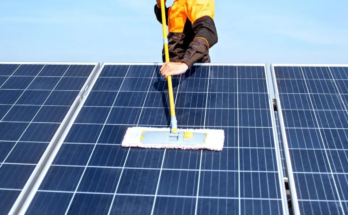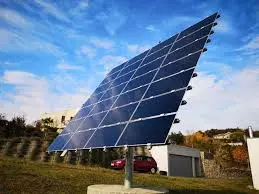Introduction: Harnessing the Power of the Sun
Have you ever looked up at the sky on a sunny day and thought, “What if I could capture all that energy and use it to power my home?” Well, it turns out, we can. Solar panels are transforming the way we think about energy. In fact, solar power is one of the fastest-growing sources of renewable energy worldwide. But how exactly do solar panels work? Is it as simple as just placing them on your roof? Let’s break it down in this comprehensive guide.
By the end of this article, you’ll not only understand how solar panels convert sunlight into electricity but also why they’re so crucial for the environment and your wallet.

What Are Solar Panels?
Defining Solar Panels
Solar panels, or photovoltaic (PV) panels, are devices that convert sunlight into electricity. They are typically made of multiple solar cells that use semiconductor materials to capture the sun’s energy. These cells absorb photons from sunlight and release electrons, which generate electricity. It’s a fascinating process, and the result is clean, renewable energy that can power your home or business.
Types of Solar Panels
There are several types of solar panels, each with its unique benefits and challenges:
- Monocrystalline Solar Panels: These are made from a single crystal structure, making them the most efficient and long-lasting. They tend to be more expensive but are great for maximizing space.
- Polycrystalline Solar Panels: Made from silicon crystals that are melted together, these panels are less efficient than monocrystalline panels but more affordable.
- Thin-Film Solar Panels: These panels are lightweight and flexible, though they generally have lower efficiency than crystalline panels. They are a good choice for large-scale installations and areas where space isn’t a concern.
The Science Behind Solar Panels
How Do Solar Panels Work?
At the core of solar panel technology is the photovoltaic effect—a process that converts light into electricity. This happens in the following steps:
- Photons Hit the Solar Cells: When sunlight (composed of tiny particles called photons) hits a solar panel, the silicon cells inside the panel absorb the energy.
- Electrons Are Released: The energy from the photons knocks electrons loose from their atoms within the silicon cells.
- Creating an Electric Current: The freed electrons flow through the material, generating an electric current. This current is then captured by the wiring embedded in the panel.
- Conversion to Usable Electricity: The electric current generated by the solar cells is direct current (DC). However, homes and businesses use alternating current (AC), so an inverter is used to convert the DC into AC.

Photovoltaic Cells: The Heart of the Panel
Each solar panel is made up of photovoltaic cells that are composed of semiconductors, most commonly silicon. These cells are arranged in a grid-like pattern. The semiconductor material has a positive and negative side, creating an electric field. When photons hit the cells, they excite electrons and cause them to flow toward the negative side, creating electricity.
The Solar Panel System
Components of a Solar Panel System
A solar power system consists of more than just panels on the roof. To efficiently capture and use solar energy, several components work together:
- Solar Panels: These are the main components that capture sunlight and convert it into electricity.
- Inverter: As mentioned earlier, solar panels generate direct current (DC) electricity. The inverter converts this DC into alternating current (AC), which is used to power your home or business.
- Solar Battery: Some systems include solar batteries, which store excess energy generated during the day for use at night or during cloudy days.
- Charge Controller: If you’re using solar batteries, a charge controller is essential to regulate the voltage and current coming from the solar panels, ensuring the batteries charge safely.
- Electrical Meter: This monitors the energy produced by your solar system and tracks how much energy you’re sending back to the grid (if applicable).
Solar Panel Installation: Step-by-Step
Getting solar panels installed is an exciting process! Here’s a simplified overview of what to expect during installation:
- Consultation and Design: The first step involves a consultation with a solar installer. They’ll assess your roof’s suitability for solar panels, the amount of sunlight your location receives, and your energy needs. Based on this, they’ll design a custom system for your home.
- Site Assessment: The installer will perform a site assessment to measure the available space, check the roof’s condition, and identify any potential shading issues.
- Installation: Once everything is set, the installers will mount the panels, set up the inverter, and connect the system to your home’s electrical system.
- Inspection and Activation: After installation, the system will be inspected by local authorities to ensure it meets safety codes. Once approved, it will be activated, and you’ll be able to start generating your own solar power.

Advantages of Solar Panels
1. Clean and Renewable Energy
One of the main advantages of solar panels is that they provide clean, renewable energy. Unlike fossil fuels, solar power doesn’t produce harmful emissions, helping to combat climate change and reduce your carbon footprint.
2. Cost Savings
While the initial investment in solar panels can be high, the long-term savings are significant. By generating your own electricity, you can reduce or even eliminate your monthly energy bills. Many areas also offer incentives and rebates for solar installations, making it more affordable.
3. Low Maintenance
Solar panels are generally low-maintenance once installed. They don’t require much beyond occasional cleaning to remove dirt or debris. Most panels come with warranties lasting 20-25 years, and the technology is designed to last for decades.
4. Energy Independence
Solar panels give you greater control over your energy source. Instead of relying on the grid, you can produce your own power, making you less vulnerable to rising energy prices and potential power outages.
Environmental Benefits of Solar Energy
Reducing Greenhouse Gas Emissions
Solar energy is one of the cleanest sources of electricity, with no emissions or pollutants released into the atmosphere. By reducing the need for fossil fuels, solar power plays a crucial role in reducing greenhouse gas emissions, which are a major contributor to global warming.
Conserving Water
Unlike traditional power plants that require large amounts of water for cooling, solar power systems don’t use water in the energy generation process. This helps conserve vital water resources and reduces the strain on local water supplies.
Decreasing Dependence on Fossil Fuels
Fossil fuels are finite resources, and relying on them for energy is unsustainable in the long term. Solar energy provides an infinite, renewable source of power, helping reduce dependence on fossil fuels and move toward a cleaner, more sustainable energy future.
How Much Do Solar Panels Cost?
Initial Installation Costs
The cost of solar panel installation depends on several factors, including the size of the system, the type of panels, and the complexity of the installation. On average, homeowners in the U.S. can expect to pay between $15,000 and $25,000 for a full solar panel system, though prices have dropped significantly over the past decade.
Incentives and Rebates
There are various incentives available to help offset the cost of solar panel installation. The Federal Investment Tax Credit (ITC) allows homeowners to deduct a percentage of the installation cost from their federal taxes. Many states and local governments also offer rebates, grants, and tax incentives for solar installation.
Long-Term Savings
Although the upfront costs can be significant, the savings over time can make solar panels a smart investment. Many homeowners report saving thousands of dollars on energy bills over the life of the system. Additionally, installing solar panels can increase the value of your home.
Solar Panels vs. Other Renewable Energy Sources
Wind Energy
While wind energy is another renewable resource, it typically requires more space and specific conditions to be effective. Wind turbines are also more expensive to install and maintain than solar panels. Solar power is often a more accessible and cost-effective solution for residential properties.
Hydropower
Hydropower is another renewable energy source, but it requires access to flowing water and the construction of dams or other infrastructure. For most homeowners, solar power is a simpler and more viable option.
Biomass
Biomass energy involves using organic materials, like wood or agricultural waste, to generate power. While biomass is renewable, it still releases carbon dioxide when burned, unlike solar power, which is entirely emission-free.
The Future of Solar Power
Solar Panel Efficiency Improvements
As technology advances, solar panels are becoming more efficient. Researchers are constantly working on new materials and techniques to increase the energy conversion rate of solar panels, making them more powerful and cost-effective.
Solar Roofs and Building-Integrated Photovoltaics (BIPV)
In the future, we may see solar power integrated directly into the design of buildings. Solar roofs and building-integrated photovoltaics (BIPV) are already in development, and they could become more mainstream as the technology advances. This could lead to even greater energy efficiency and aesthetics for homeowners.
Solar Power Storage
Solar power storage is another area of development. While solar batteries are already available, they are still relatively expensive. As battery technology improves and prices drop, storing excess solar energy for use at night or during cloudy days will become more efficient and affordable.
Read this: AI in Supply Chain Optimization for Agricultural Products
Conclusion: A Bright Future for Solar Power
Solar power is an exciting and rapidly evolving field that offers a sustainable, cost-effective solution to our growing energy needs. From reducing your carbon footprint to saving money on your utility bills, solar panels offer a range of benefits for homeowners and the environment alike. As technology continues to improve, the future of solar energy looks even brighter.
If you’re considering making the switch to solar, now is the perfect time. With increasing affordability, incentives, and the environmental benefits, solar power is poised to play a key role in the clean energy revolution.
FAQs
1. How much energy can solar panels produce?
The amount of energy solar panels produce depends on factors like the size of the system, geographic location, and panel efficiency. On average, a typical residential solar system can produce between 5,000 to 8,000 kWh of electricity annually.
2. Do solar panels work on cloudy days?
Yes, solar panels can still generate electricity on cloudy days, though at a reduced rate. They rely on sunlight, but even diffused light can produce some energy.
3. How long do solar panels last?
Most solar panels last 25-30 years. Many come with warranties of 20-25 years, but they can continue to produce electricity beyond that period, albeit at a slightly reduced efficiency.
4. Can I install solar panels myself?
While it is technically possible to install solar panels yourself, it’s generally not recommended. Professional installers ensure that the system is set up safely and efficiently and comply with local regulations.
5. What happens if my solar panels produce more energy than I need?
If your solar system generates more energy than you use, the excess power is sent back to the grid, often in exchange for credits through a system called net metering. This can help offset your energy bills or even earn you money.


